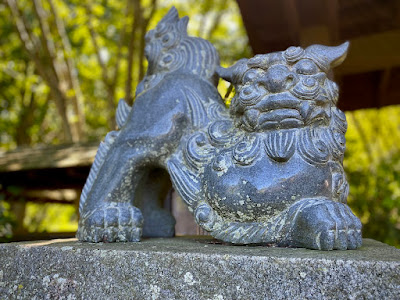Located within the Lewis Landscape Arboretum of Michigan State University, resides the Kathleen D. & Milton E. Muelder Japanese Garden. Locating information about this garden online has been a bit of a challenge. I believe that it was dedication in 2000, but I could be mistaken. The only other info I have is from two plaques located at the garden itself.
The garden was designed to reflect three distinct styles of Japanese gardening: hill & pond, dry landscape, and stroll garden.
The main feature of this garden is the dry landscape garden surrounded by walls with stones and rakable gravel placed within.
Around this structure there are a series of pathways which traverse through the surrounding plantings and is populated by a couple of lanterns and a small pond.
The main entrance to the garden was flanked by two large "Shi Shi" lions. The one with mouth closed keeps evil spirits in, while the one with mouth open lets good spirts out. These appear to have been placed at the garden in 2001.
The design of the dry landscape garden is good and even includes a sitting area along one edge for visitors to take in the view and meditate on the experience.
A large coin-style Tsukubai water basin rests at the entryway, but appears to be a water-less feature.
The wooden structure is in need of some serious repair and is showing its age (at least 22 years). The gravel is also in need of some attention. Unfortunately, visitors do not seem to understand the nature of a Japanese dry landscape garden and simply walk over or through the gravel, even leaving stones within that detract from the garden (this occurred while I was sitting on the bench and watched a parent allow their child to run about and play in the gravel).
There is also a second entrance to the dry landscape garden. Outside is a small natural style water basin, again devoid of actual water.
From my perspective, the problem is with the second entrance. For many visitors it is the first entrance they encounter, but most do not realize it is an exit. By sealing it off, and using only a single entry/exit way, the garden managers could place appropriate signage informing visitors about the purpose of a dry landscape garden and offer encouragement to respect the feature. Guard rails would also help. However, as long as the garden is neglected, it will send the message to visitors that they are free to traverse wherever they chose within the landscape. These simple adjustments would go along way to preserve the nature and intent of the garden, both of which are meant to educate people abut Japanese garden design.
Overall, a very nice garden that needs some love and care, and perhaps some new funding to rebuild the structure and restore the garden.

















